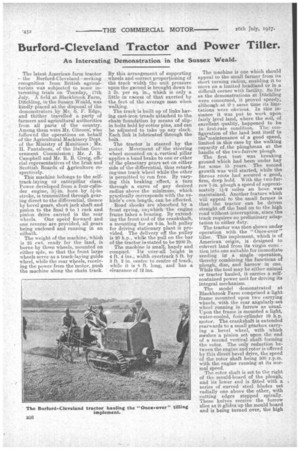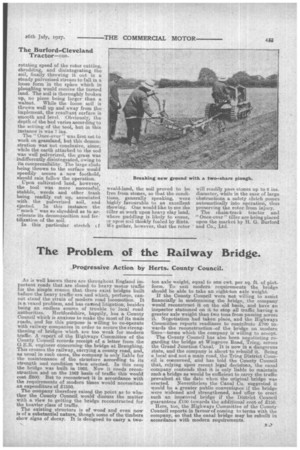Burford-Cleveland Tractor and Power Tiller.
Page 8

Page 9

If you've noticed an error in this article please click here to report it so we can fix it.
An Interesting Demonstration in the Sussex Weald.
The latest American farm tractor — the Burford-Cleveland—seeking recognition from' British agricul turists was subjected to some interesting trials on Tuesday, 17th • July. A field at Blackbrook .17th Ditchling, in the Sussex Weald, was kindly placed at the disposal of the demonstrators by Mr. 8. F. Edge, and thither travelled a party of farmers and agricultural authorities from all parts of the country. Among them were Mr. Citroen, who followed the operations on behalf of the Agricultural Machinery Dept. of the Ministry of Munitions ; Mr. H. Pa,ntaleoni, of the Italian Government Commission ; Mr. J. R. Campbell and Mr. R. B. G'reig, offi-' cial representatives of the Irish and Scottish Boards of 4griculture respectively.
This machine belongs to the selftrack-laying or caterpillar clasis. Power developed from a four-cylinder engine, 31-in. bore by 5iT-in
stroke, is transmitted through gearing direct to the differential, thence by bevel•gears, short jack shaft and
pinion to the final 9 to 1 rack and pinion drive carried -in the sear
wheels. One speed forward and one reverse are provided, all gears being enclosed and running in an oilbath. . The weight of the machine, which is 25 cwt. ready for the land, is borne by three wheels, mounted on either side, so that the front large wheels serve as a track-laying guide wheel, while the rear wheels, receiving the power from the motor, push the machine alone the chain track. By this arrangement of supporting wheels and correct proportioning of the track 'width the unit pressure upon the gsound is brought down to 5 lb. per sq. in., which is only a little in excess of that exerted by the feet of the average man when walking.
The track is built up of links having cast-iron,treads attached to the chain 'foundation by means of slipin bolts held by cotter pins', and can be adjusted to take up any slack. Each link is lubricated through the bolt.
The tractor is steered by the motor. Movement of the steering wheel mounted' on.a. vertical pillar applies a band brake to one or other of the planetary gears set on either side of the .differential, thus retarding,One track 'wheel While the other is permitted to run free. By varying this braking effect, a turn through a curve of any desired radius above the minimum, which practically corresponds with the vehicle's own length, can be effected. Road shocks are absorbed by a front spring, oniwhich the engine frame takes a bearing. By extending the front erid of the crankshaft, a mounting for an 8-in, belt pulley for driving stationary plant is provided. The delivery off the pulley is 29 h.p., while the pull on the bar of the tractor ie stated to be 2200 lb.
The machine is small, handy and compact. Its over-all height is 4 ft. 4 ins., width overtrack 5 ft. by 3 ft. 2 in. centre to centre of track, while it is s ft. long, and has a clearance of 12 ins. The machine is one which should appeal to the small farmer from its short turning radius, enabling it to
move on a, limited headland or in a difficult corner with facility. So far as the demonstrations at Ditchling
were concerned, it proved speedy, although at same time its limi tations were obvious. In this in stance it was put to work upon fairly kevel land, where the soil, of excellent quality, happened to be in first-rate condition, The configuration of the land lent itself to the'maintetiance of a good speed; limited in this case by the walking capacity of .the ploughman at the handle of the two-furrow plough.
The first test was breaking ground which had been under hay for some 15 years. The second growth was well started, while the fibrous riots had secured a good, firm, deep hold. With the two-fur
row 7-in, plough a speed of approximately 1?2-2 miles an hour. was
maintained. Another feature which will appeal to the small farmer is that the tractor can be driven straight off the land on to the high road without interruption, since the track requires no preliminary adaptation to either duty.
The tractor was then shown under operation with the " Once-over " tiller. This implement, which is of American origin, is designed to colivert land from its virgin conci tion into one suitable for immediate seeding irr a single operation, thereby combining the functions of
plough, disc, and harrowin one. While the.tool may be either animal or tractor hauled, it carries a, self-' contained power unit for driving its integral mechanism.
The model demonstrated at Blackbrook Farm comprised a light frame mounted upon two carrying wheels, with the rear angularly-set wheel running in furrow as usual. Upon the frame is mounted a. light, water-cooled, four-cylinder 10 h.p.
motor. The crankshaft is extended rearwards to a small gearbox carry
ing a bevel wheel, with which meshes a pinion set upon the end of a second vertical shaft forming
the rotor. The only reduction between the engine and rotor is offered by this direct bevel drive, the speed of the rotor shaft being 500 r.p.m. with the engine running at its normal speed.
The rotor shaft is set to the right of the mould-board of the plough, and its lower end is fitted with a, series of curved steel blades set radially one above the other, with 'cutting edges stepped spirally. These knives receive the furrow slice as it glides up the mould board and is being turned over, the high rotating speed of the rotor cutting, shredding, and disintegrating the soil, finally throwing it out in a steady pulverised stream to fall in a loose form in the spkce which in ploughing would receive the turned land. The soil is thoroughly broken up, no piece being larger than a walnut. While the loose soil is thrown well up and away from the implement, the resultant surface is smooth and level. Obviously, the depth of the bed varies according to the setting of the tool, but in this instance is was 7 ins.
The " Once-over " was first set to work on grassland, but this demonstration was not conclusive, since, while the earth attached to the sod was well pulverized, the grass was indifferently disintegrated, owing to its compressibility. The large clods being thrown to the surface would speedily secure a new foothold, should rain follow the operation.
Upon cultivated land, however, the tool was more successful, stubble, weeds and other trash being readily cut up, associated with the pulverized soil, and ejected. In this instance the " muck " was so shredded as to accelerate its decomposition and fertilization of the soil.
In this particular stretch if
weald-land, the soil proved to be free from stones, so that the conditions, generally speaking, were highly favourable to an excellent showing. One would like to see the tiller at work upon heavy clay land, where puddling is likely to ensue, or upon sail thickly fouled by flints. We gather, however, that the rotor will readily pass stones up to 6 ins. diameter, while in the case of large obetructiona a safety clutch comes automatically into operation, thus preserving the rotor from injury. The chain-track tractor and " Once-over" tiller are being placed upon the market by H. G. Burford and Co., Ltd.




















